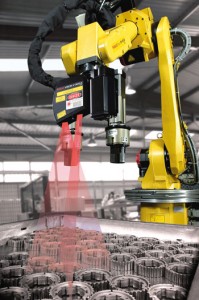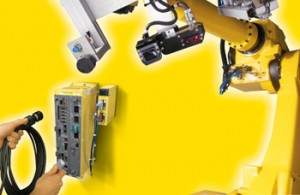Vision technology expands food industry applications
 Adding ‘sight’ to a robot can expand its potential in food industry applications. FANUC can offer the perfect solution, iRVision, an integrated vision solution option for its robots – featuring both software and hardware components.
Adding ‘sight’ to a robot can expand its potential in food industry applications. FANUC can offer the perfect solution, iRVision, an integrated vision solution option for its robots – featuring both software and hardware components.
Coming as an optional software module of the R-30iB controller, iRVision is perfect for use in food and packaging applications. Within the iRVision package are iRVision 2D, iRVision 2.5D, iRVision 3D, iRVision 3DL (laser) and iRVision 3D area sensor – together with a range of associated hardware components. Cameras can be high-resolution, low-resolution or colour, depending on the application requirements.
The flexibility and intelligence of a robot with the benefit of vision enables high-level functions, such as picking, inspection, bar code and data matrix recognition and line tracking to be achieved. It offers an automated solution that is able to mimic the hand-eye coordination of a human and can accurately pick random products off a conveyor. In the food sector robots can be used to automate a host of vital inspection, positioning and orientation tasks, while its code reading capabilities can play a key role in helping food companies to meet product traceability requirements.
“Robots are increasingly finding applications in the food sector – for pick-and-place product handling applications as well as their more well used application, helping to increase end of line productivity by speeding up packaging and palletising capabilities.”
Explaining further, Darren Whittall, technical manager at FANUC Robotics (UK), said: “Integrating vision into the control package allows food companies to incorporate features such as visual line tracking into their robotic setups without the need for external PCs.”
A common requirement in the food industry, visual line tracking involves a camera looking at products moving along a conveyor belt. The vision system identifies the position of an object on the conveyor and passes this information to a robot further down the conveyor, which can then pick the product.
 “FANUC also now has the ability to offer a user-friendly and graphically driven way of programming visual line tracking applications and enables single camera/multiple robot applications. In simple terms this feature allows one robot to look after the camera and line tracking capability, passing the data on to the other robots. This solution enables less hardware to be specified,” said Whittall.
“FANUC also now has the ability to offer a user-friendly and graphically driven way of programming visual line tracking applications and enables single camera/multiple robot applications. In simple terms this feature allows one robot to look after the camera and line tracking capability, passing the data on to the other robots. This solution enables less hardware to be specified,” said Whittall.
iRVision offers the most cost-effective vision solution for users of FANUC robots. Because it is an integrated part of the controller, no third-party software is needed to run or programme the vision system which means there will be no additional integration costs, which would be required to enable a third-party vision system to communicate with the robot. iRVision offers a simple, plug-and-play solution. Set up is via the iPendant Touch, a handheld pendant that acts as the interface between the operator and the controller. “iPendant Touch offers some impressive graphics capabilities which makes it easy to set up vision applications. Its 3D graphics capability also allows users to see line tracking system parameters in 3D which helps to visualise the application,” said Whittall.
“FANUC Robotics is able to organise training courses for vision novices, and in complicated vision applications we can bring in our own vision experts to advise on system set up and lighting requirements,” he continued.
Asked why users would choose an iRVision solution, when there are so many vision systems on the market today, Whittall said: “The easy answer to this is because it works out of the box! There is no need to implement your own communication protocols between the camera and the robot. iRVision can offer a truly plug-and-play solution. If you are using a FANUC robot with an R-30iB controller, it is the simplest vision solution. FANUC manufactures all of its equipment and designs its own software so everything will, naturally, work well together without the need for a huge amount of integration work.”
Visit the FANUC website for more information.
See all stories for FANUC















